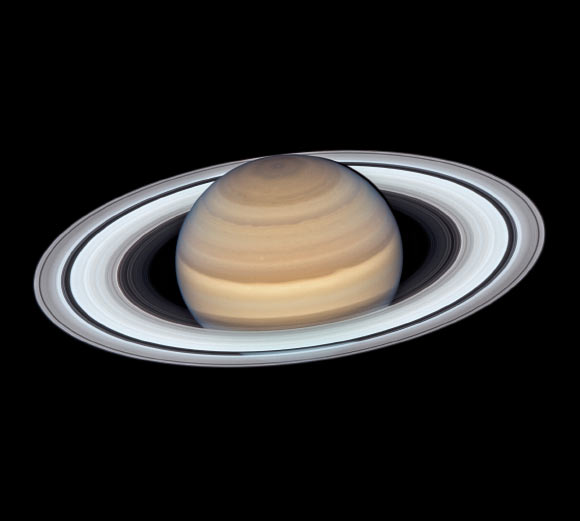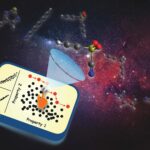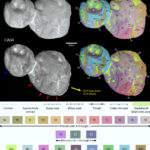Saturn’s rings could have evolved from the debris of two progenitor icy moons that collided and shattered a few hundred million years ago; debris that didn’t end up in the rings could also have contributed to the formation of some of Saturn’s present-day moons, according to new simulations carried out by planetary researcher from the University of Glasgow, the University of Oslo, NASA’s Ames Research Center, SETI Institute and Durham University.
Teodoro et al. simulated the collision of precursor icy moons analogous to Dione and Rhea as a possible origin for Saturn’s remarkably young rings. Such an event could have been triggered a few hundred million years ago by resonant instabilities in a previous satellite system. Using high-resolution simulations, they found that this kind of impact can produce a wide distribution of massive objects and scatter material throughout the system. Image credit: NASA / ESA / Hubble / A. Simon, NASA’s Goddard Space Flight Center / M.H. Wong, University of California, Berkeley / OPAL Team.
Most contemporary high-quality measurements about Saturn have come from NASA’s Cassini spacecraft that spent 13 years studying the planet and its systems after entering Saturn’s orbit in 2004.
An analysis of Cassini data indicated that Saturn’s rings were much younger than first thought.
To investigate this further, Dr. Jacob Kegerreis from NASA’s Ames Research Center and his colleagues modeled what different collisions between precursor moons in Saturn’s system may have looked like.
“There’s so much we still don’t know about the Saturn system, including its moons that host environments that might be suitable for life,” Dr. Kegerreis said.
“So, it’s exciting to use big simulations like these to explore in detail how they could have evolved.”
The team’s simulations were conducted at a resolution more than 100 times higher than previous such studies, using the open-source simulation code SWIFT and giving scientists their best insights into the Saturn system’s history.
Saturn’s rings today live close to the giant planet, within what’s known as the Roche limit — the farthest orbit where a planet’s gravitational force is powerful enough to disintegrate larger bodies of rock or ice that get any closer. Material orbiting farther out could clump together to form moons.
By simulating almost 200 different versions of the impact, the researchers discovered that a wide range of collision scenarios could scatter the right amount of ice into Saturn’s Roche limit, where it could settle into rings.
And, while alternative explanations haven’t been able to show why there would be almost no rock in Saturn’s rings, this type of collision could explain that.
“This scenario naturally leads to ice-rich rings. When the icy progenitor moons smash into one another, the rock in the cores of the colliding bodies is dispersed less widely than the overlying ice,” said Dr. Vincent Eke, a researcher at Durham University.
Ice and rocky debris would also have hit other moons in the system, potentially causing a cascade of collisions.
Such a multiplying effect could have disrupted any other precursor moons outside the rings, out of which today’s moons could have formed.
But what could have set these events in motion, in the first place? Two of Saturn’s former moons could have been pushed into a collision by the usually small effects of the Sun’s gravity ‘adding up’ to destabilize their orbits around the planet.
In the right configuration of orbits, the extra pull from the Sun can have a snowballing effect — a resonance — that elongates and tilts the moons’ usually circular and flat orbits until their paths cross, resulting in a high-speed impact.
Saturn’s moon Rhea today orbits just beyond where a moon would encounter this resonance.
Like the Earth’s Moon, Saturn’s satellites migrate outward from the planet over time.
So, if Rhea was ancient, it would have crossed the resonance in the recent past.
However, Rhea’s orbit is very circular and flat. This suggests that it did not experience the destabilizing effects of the resonance and, instead, formed more recently.
“We conclude that the impact of two destabilized icy moons is a promising scenario for the recent formation or rejuvenation of Saturn’s rings and reaccretion of mid-sized moons,” the scientists concluded.
“Future work on the long-term evolution of the orbit-crossing debris, combined with further and more detailed modeling of collisions between both icy moons and smaller fragments, will help to constrain the implications of this scenario for Saturn’s rings, its moons, their craters, and other surface environments.”
Their paper appears in the Astrophysical Journal.
_____
L.F.A. Teodoro et al. 2023. A Recent Impact Origin of Saturn’s Rings and Mid-sized Moons. ApJ 955, 137; doi: 10.3847/1538-4357/acf4ed




